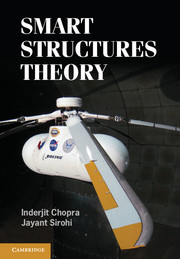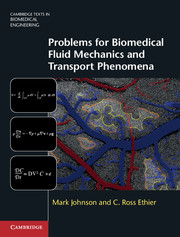Refine search
Actions for selected content:
5487 results in Thermal-fluids engineering
Preface
-
- Book:
- Smart Structures Theory
- Published online:
- 18 December 2013
- Print publication:
- 30 December 2013, pp xvii-xviii
-
- Chapter
- Export citation
3 - Shape Memory Alloys (SMAs)
-
- Book:
- Smart Structures Theory
- Published online:
- 18 December 2013
- Print publication:
- 30 December 2013, pp 194-304
-
- Chapter
- Export citation
Contents
-
- Book:
- Smart Structures Theory
- Published online:
- 18 December 2013
- Print publication:
- 30 December 2013, pp vii-xvi
-
- Chapter
- Export citation
4 - Beam Modeling with Induced-Strain Actuation
-
- Book:
- Smart Structures Theory
- Published online:
- 18 December 2013
- Print publication:
- 30 December 2013, pp 305-445
-
- Chapter
- Export citation
5 - Plate Modeling with Induced-Strain Actuation
-
- Book:
- Smart Structures Theory
- Published online:
- 18 December 2013
- Print publication:
- 30 December 2013, pp 446-580
-
- Chapter
- Export citation

Smart Structures Theory
-
- Published online:
- 18 December 2013
- Print publication:
- 30 December 2013

Problems for Biomedical Fluid Mechanics and Transport Phenomena
-
- Published online:
- 18 December 2013
- Print publication:
- 09 December 2013
5 - Momentum boundary layers
-
- Book:
- Problems for Biomedical Fluid Mechanics and Transport Phenomena
- Published online:
- 18 December 2013
- Print publication:
- 09 December 2013, pp 60-65
-
- Chapter
- Export citation
8 - Non-Newtonian blood flow
-
- Book:
- Problems for Biomedical Fluid Mechanics and Transport Phenomena
- Published online:
- 18 December 2013
- Print publication:
- 09 December 2013, pp 74-79
-
- Chapter
- Export citation
Appendix A - Material properties of fluids
-
- Book:
- Problems for Biomedical Fluid Mechanics and Transport Phenomena
- Published online:
- 18 December 2013
- Print publication:
- 09 December 2013, pp 156-157
-
- Chapter
- Export citation
14 - Concentration and thermal boundarylayers
-
- Book:
- Problems for Biomedical Fluid Mechanics and Transport Phenomena
- Published online:
- 18 December 2013
- Print publication:
- 09 December 2013, pp 135-141
-
- Chapter
- Export citation
Dedication
-
- Book:
- Problems for Biomedical Fluid Mechanics and Transport Phenomena
- Published online:
- 18 December 2013
- Print publication:
- 09 December 2013, pp v-vi
-
- Chapter
- Export citation
Frontmatter
-
- Book:
- Problems for Biomedical Fluid Mechanics and Transport Phenomena
- Published online:
- 18 December 2013
- Print publication:
- 09 December 2013, pp i-iv
-
- Chapter
- Export citation
2 - Conservation of mass and theReynolds transport theorem
-
- Book:
- Problems for Biomedical Fluid Mechanics and Transport Phenomena
- Published online:
- 18 December 2013
- Print publication:
- 09 December 2013, pp 16-22
-
- Chapter
- Export citation
11 - Steady diffusion and conduction
-
- Book:
- Problems for Biomedical Fluid Mechanics and Transport Phenomena
- Published online:
- 18 December 2013
- Print publication:
- 09 December 2013, pp 90-102
-
- Chapter
- Export citation
1 - Problem solving
-
- Book:
- Problems for Biomedical Fluid Mechanics and Transport Phenomena
- Published online:
- 18 December 2013
- Print publication:
- 09 December 2013, pp 1-15
-
- Chapter
- Export citation
16 - Osmotic pressure
-
- Book:
- Problems for Biomedical Fluid Mechanics and Transport Phenomena
- Published online:
- 18 December 2013
- Print publication:
- 09 December 2013, pp 151-155
-
- Chapter
- Export citation
Appendix B - Transport equations
-
- Book:
- Problems for Biomedical Fluid Mechanics and Transport Phenomena
- Published online:
- 18 December 2013
- Print publication:
- 09 December 2013, pp 158-161
-
- Chapter
- Export citation
9 - Dimensional analysis
-
- Book:
- Problems for Biomedical Fluid Mechanics and Transport Phenomena
- Published online:
- 18 December 2013
- Print publication:
- 09 December 2013, pp 80-86
-
- Chapter
- Export citation
7 - Problems involving surface tension
-
- Book:
- Problems for Biomedical Fluid Mechanics and Transport Phenomena
- Published online:
- 18 December 2013
- Print publication:
- 09 December 2013, pp 70-73
-
- Chapter
- Export citation
